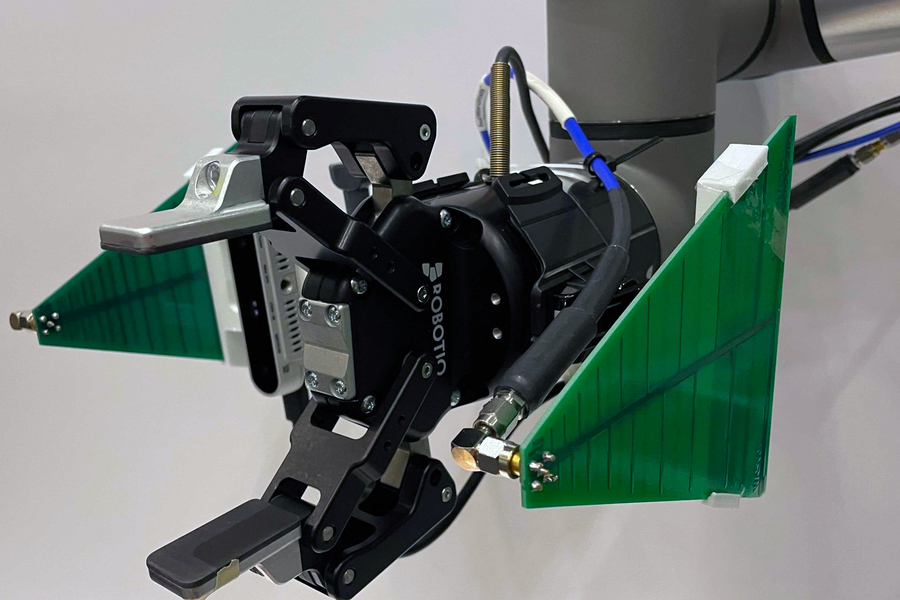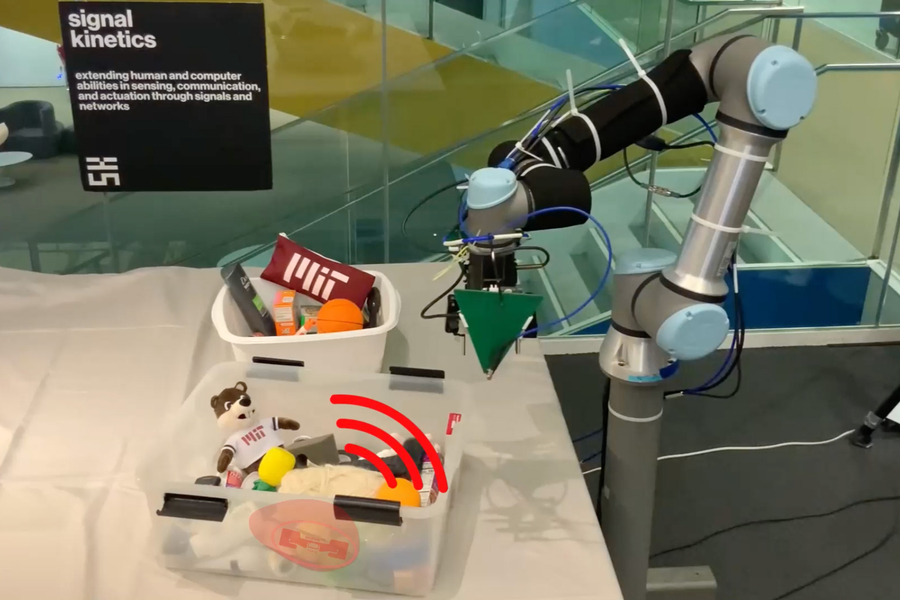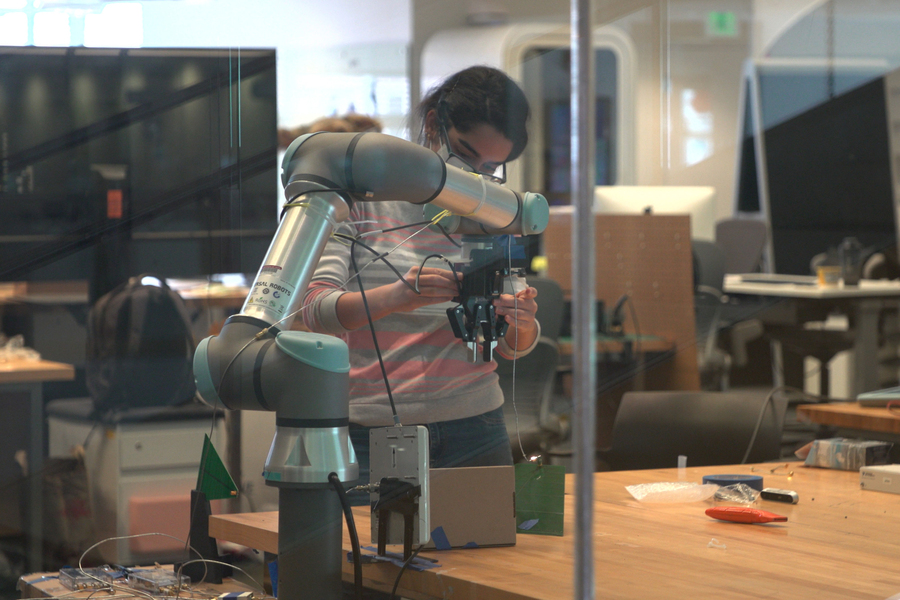New technology can make manual labor 60 percent easier
A robot that finds lost items

Researchers at MIT have developed a fully-integrated robotic arm that fuses visual data from a camera and radio frequency (RF) information from an antenna to find and retrieve objects, even when they are buried under a pile and fully out of view. Credits: Courtesy of the researchers
By Adam Zewe | MIT News Office
A busy commuter is ready to walk out the door, only to realize they’ve misplaced their keys and must search through piles of stuff to find them. Rapidly sifting through clutter, they wish they could figure out which pile was hiding the keys.
Researchers at MIT have created a robotic system that can do just that. The system, RFusion, is a robotic arm with a camera and radio frequency (RF) antenna attached to its gripper. It fuses signals from the antenna with visual input from the camera to locate and retrieve an item, even if the item is buried under a pile and completely out of view.
The RFusion prototype the researchers developed relies on RFID tags, which are cheap, battery-less tags that can be stuck to an item and reflect signals sent by an antenna. Because RF signals can travel through most surfaces (like the mound of dirty laundry that may be obscuring the keys), RFusion is able to locate a tagged item within a pile.
Using machine learning, the robotic arm automatically zeroes-in on the object’s exact location, moves the items on top of it, grasps the object, and verifies that it picked up the right thing. The camera, antenna, robotic arm, and AI are fully integrated, so RFusion can work in any environment without requiring a special set up.

In this video still, the robotic arm is looking for keys hidden underneath items. Credits: Courtesy of the researchers
While finding lost keys is helpful, RFusion could have many broader applications in the future, like sorting through piles to fulfill orders in a warehouse, identifying and installing components in an auto manufacturing plant, or helping an elderly individual perform daily tasks in the home, though the current prototype isn’t quite fast enough yet for these uses.
“This idea of being able to find items in a chaotic world is an open problem that we’ve been working on for a few years. Having robots that are able to search for things under a pile is a growing need in industry today. Right now, you can think of this as a Roomba on steroids, but in the near term, this could have a lot of applications in manufacturing and warehouse environments,” said senior author Fadel Adib, associate professor in the Department of Electrical Engineering and Computer Science and director of the Signal Kinetics group in the MIT Media Lab.
Co-authors include research assistant Tara Boroushaki, the lead author; electrical engineering and computer science graduate student Isaac Perper; research associate Mergen Nachin; and Alberto Rodriguez, the Class of 1957 Associate Professor in the Department of Mechanical Engineering. The research will be presented at the Association for Computing Machinery Conference on Embedded Networked Senor Systems next month.
Sending signals
RFusion begins searching for an object using its antenna, which bounces signals off the RFID tag (like sunlight being reflected off a mirror) to identify a spherical area in which the tag is located. It combines that sphere with the camera input, which narrows down the object’s location. For instance, the item can’t be located on an area of a table that is empty.
But once the robot has a general idea of where the item is, it would need to swing its arm widely around the room taking additional measurements to come up with the exact location, which is slow and inefficient.
The researchers used reinforcement learning to train a neural network that can optimize the robot’s trajectory to the object. In reinforcement learning, the algorithm is trained through trial and error with a reward system.
“This is also how our brain learns. We get rewarded from our teachers, from our parents, from a computer game, etc. The same thing happens in reinforcement learning. We let the agent make mistakes or do something right and then we punish or reward the network. This is how the network learns something that is really hard for it to model,” Boroushaki explains.
In the case of RFusion, the optimization algorithm was rewarded when it limited the number of moves it had to make to localize the item and the distance it had to travel to pick it up.
Once the system identifies the exact right spot, the neural network uses combined RF and visual information to predict how the robotic arm should grasp the object, including the angle of the hand and the width of the gripper, and whether it must remove other items first. It also scans the item’s tag one last time to make sure it picked up the right object.
Cutting through clutter
The researchers tested RFusion in several different environments. They buried a keychain in a box full of clutter and hid a remote control under a pile of items on a couch.
But if they fed all the camera data and RF measurements to the reinforcement learning algorithm, it would have overwhelmed the system. So, drawing on the method a GPS uses to consolidate data from satellites, they summarized the RF measurements and limited the visual data to the area right in front of the robot.
Their approach worked well — RFusion had a 96 percent success rate when retrieving objects that were fully hidden under a pile.

“We let the agent make mistakes or do something right and then we punish or reward the network. This is how the network learns something that is really hard for it to model,” co-author Tara Boroushaki, pictured here, explains. Credits: Courtesy of the researchers
“Sometimes, if you only rely on RF measurements, there is going to be an outlier, and if you rely only on vision, there is sometimes going to be a mistake from the camera. But if you combine them, they are going to correct each other. That is what made the system so robust,” Boroushaki says.
In the future, the researchers hope to increase the speed of the system so it can move smoothly, rather than stopping periodically to take measurements. This would enable RFusion to be deployed in a fast-paced manufacturing or warehouse setting.
Beyond its potential industrial uses, a system like this could even be incorporated into future smart homes to assist people with any number of household tasks, Boroushaki says.
“Every year, billions of RFID tags are used to identify objects in today’s complex supply chains, including clothing and lots of other consumer goods. The RFusion approach points the way to autonomous robots that can dig through a pile of mixed items and sort them out using the data stored in the RFID tags, much more efficiently than having to inspect each item individually, especially when the items look similar to a computer vision system,” says Matthew S. Reynolds, CoMotion Presidential Innovation Fellow and associate professor of electrical and computer engineering at the University of Washington, who was not involved in the research. “The RFusion approach is a great step forward for robotics operating in complex supply chains where identifying and ‘picking’ the right item quickly and accurately is the key to getting orders fulfilled on time and keeping demanding customers happy.”
The research is sponsored by the National Science Foundation, a Sloan Research Fellowship, NTT DATA, Toppan, Toppan Forms, and the Abdul Latif Jameel Water and Food Systems Lab.
Robohub gets a fresh look

If you visited Robohub this week, you may have spotted a big change: how this blog looks now! On Tuesday (coinciding with Ada Lovelace Day and our ‘50 women in robotics that you need to know about‘ by chance), Robohub got a massive modernisation on its look by our Technical Editor Ioannis K. Erripis and his team.
There are many improvements and new features but the biggest update apart from the code is the design which is more clean and simple looking (especially on the single post view).
Ioannis K. Erripis
This fresher look has recently been tested on our sister project, AIhub.org. As Ioannis says, it offers a cleaner, simpler and more readable way to access the content from the robotics community that we post in this blog. You will also notice that the main page now displays a mosaic of content which is more accessible than before to facilitate how you scroll down our site.
Your feedback matters to us: if you find any issue with the new design or have any comment/idea for improvement, please let us know! You can reach us at editors[at]robohub.org.
And there are even more exciting news coming up together with this fresh look! We will soon release a brand new project that we have been developing in the background during this year. Stay tuned!
How to make an exosuit that helps with awkward lifts
Closing the AI Ambition – Execution Gap in Manufacturing
A new model to enable multi-object tracking in unmanned aerial systems
Tiny hand-shaped gripper can grasp and hold a snail’s egg
10 Things to Consider When Exploring Offline Robot Programming Software Solutions
Researchers build $400 self-navigating smart cane
The Mini Series Takes a Taxi
High Capacity Ride Sharing

In this episode, our interviewer Lilly speaks to Alex Wallar, co-founder and CTO of The Routing Company. Wallar shares his background in multi-robot path-planning and optimization, and his research on scheduling and routing algorithms for high-capacity ride-sharing. They discuss how The Routing Company helps cities meet the needs of their people, the technical ins and outs of their dispatcher and assignment system, and the importance of public transit to cities and their economics.

Alex Wallar
Alex Wallar is Co-founder and CTO of the Routing Company, an on-demand vehicle routing and management platform that partners with cities to power the future of public transit. Previously he was pursuing a PhD in the Computer Science and Artificial Intelligence Lab at MIT, conducting research on mathematical optimization for high-capacity ride-sharing.
Links
- Download mp3 (41.7 MB)
- Subscribe to Robohub using iTunes, RSS, or Spotify
- Support us on Patreon
#339: High Capacity Ride Sharing, with Alex Wallar

In this episode, our interviewer Lilly speaks to Alex Wallar, co-founder and CTO of The Routing Company. Wallar shares his background in multi-robot path-planning and optimization, and his research on scheduling and routing algorithms for high-capacity ride-sharing. They discuss how The Routing Company helps cities meet the needs of their people, the technical ins and outs of their dispatcher and assignment system, and the importance of public transit to cities and their economics.

Alex Wallar
Alex Wallar is Co-founder and CTO of the Routing Company, an on-demand vehicle routing and management platform that partners with cities to power the future of public transit. Previously he was pursuing a PhD in the Computer Science and Artificial Intelligence Lab at MIT, conducting research on mathematical optimization for high-capacity ride-sharing.
Links
- Download mp3 (41.7 MB)
- Subscribe to Robohub using iTunes, RSS, or Spotify
- Support us on Patreon
How a Team United in Just 18 Months to Overhaul How America Destroys Its Most Dangerous Chemical Weapons
50 women in robotics you need to know about 2021
It’s Ada Lovelace Day and once again we’re delighted to introduce you to “50 women in robotics you need to know about”! From the Afghanistan Girls Robotics Team to K.G.Engelhardt who in 1989 founded, and was the first Director of, the Center for Human Service Robotics at Carnegie Mellon, these women showcase a wide range of roles in robotics. We hope these short bios will provide a world of inspiration, in our ninth Women in Robotics list! Tweet this
In 2021, we showcase women in robotics in Afghanistan, Australia, Canada, Denmark, Finland, France, Germany, Hong Kong, India, Iran, Ireland, Israel, Italy, Japan, New Zealand, Portugal, Singapore, South Africa, Spain, Switzerland, Russia, United Kingdom and United States. They are researchers, industry leaders, and artists. Some women are at the start of their careers, while others have literally written the book, the program or the standards.
It is, however, disturbing how hard it can be to find records of women who were an important part of the history of robotics, such as K.G. Engelhardt. Statistically speaking, women are far more likely to leave the workforce or change careers due to family pressures, and that contributes to the erasure. Last year, we talked about the importance of having more equitable citation counts. The citation problem is expected to significantly disadvantage women and people of color due to the historical lack of women followed by the recent growth of large scientific teams, multiplying exclusion.
A more dangerous form of erasure is happening today in Afghanistan. The Afghanistan Girls Robotics Team was forced to flee the country, thanks to help from their support group, the Digital Citizen Fund. What steps must the international community take in support of a future for Afghan girls’ education? Hear from UN Deputy Secretary-General Amina Mohammed, Nobel Laureate and Malala Fund Co-Founder Malala Yousafzai, and Somaya Faruqi, Captain of the Afghan Dreamers Robotics Team, in this recent UN video.
You can support The Afghan Dreamers here, and soon watch a documentary about the original team which was shot with the girls in Afghanistan in 2019 and 2020.
Meanwhile, UC Davis developed an online digital backpack to keep academic credentials and school records safe and private. The Article 26 Backpack references the 1948 Universal Declaration of Human Rights, and the right to an education. At the moment, the Backpack is for people 18 and over, with a high school diploma or baccalaureate, whose education has been affected by war, conflict or economic conditions.
On the good news front, the IEEE RAS Women in Engineering (WIE) Committee recently completed a several year study of gender representation in conference leading roles at RAS-supported conferences. Individuals who hold these roles select organizing committees, choose speakers, and make final decisions on paper acceptances. In this video, the authors lead a discussion about the findings and the story behind the study. In addition to presenting detailed data and releasing anonymized datasets for further study, the authors provided suggestions on changes to help ensure a more diverse and representative robotics community where anyone can thrive. The paper “Gender Diversity of Conference Leadership” by Laura Graesser, Aleksandra Faust, Hadas Kress-Gazit, Lydia Tapia, and Risa Ulinskiby was in the June 2021 IEEE Robotics and Automation Magazine, with a follow up “Retrospective on a Watershed Moment for IEEE Robotics and Automation Society Gender Diversity [Women in Engineering]” in Sep 2021 by Lydia Tapia reporting on gender diversity initiatives undertaken by the Robotics and Automation Society.
We publish this list because the lack of visibility of women in robotics leads to the unconscious perception that women aren’t making newsworthy contributions. We encourage you to use our lists to help find women for keynotes, panels, interviews and to cite their research and include them in curricula. Tulane University published a guide to help you calculate how much of your reading list includes female authors and a citation guide, similar to the CiteHer campaign from BlackComputeher.org.
And Women in Robotics have just launched a Photo Challenge! We got so tired of seeing literally hundreds of images of female robots showing up whenever we searched for images of women building robots, or images of men building robots while women watched. Let’s push Sophia out of the top search results and showcase real women building real robots instead!
We hope you are inspired by these profiles, and if you want to work in robotics too, please join us at Women in Robotics. We are now a 501(c)(3) non-profit organization, but even so, this post wouldn’t be possible if not for the hard work of volunteers; Andra Keay, Fatemeh Pahlevan Aghababa, Jeana diNatale and Daniel Carrillo Zapata. Tweet this
And we encourage #womeninrobotics and women who’d like to work in robotics to join our professional network at http://womeninrobotics.org Want to keep reading? There are more than 200 other stories on our 2013 to 2020 lists. Why not nominate someone for inclusion next year! Tweet this